“What new products are you testing?” — they asked us, and we decided to share our experience of using a portable blender. It is truly irreplaceable, especially if you watch your health, go to the gym and prefer low-calorie smoothies in your diet. We made some delicious drinks, swapped out the standard dock for a non-motorized bottom, and we were ready to get physical. Why do we need a blender, especially a portable one, and even one with batteries?
Friends shared their experiences. For example, in the summer we went to Karelia, and we had to beat blueberries with sugar with a fork. If only we had a portable blender like this, we would make our lives easier. It doesn't need electricity — sprinkle blueberries, add sugar, and now a delicious addition to breakfast is ready. And if you simply serve blueberries with sugar in the form of puree for tea, it is also incredibly tasty.
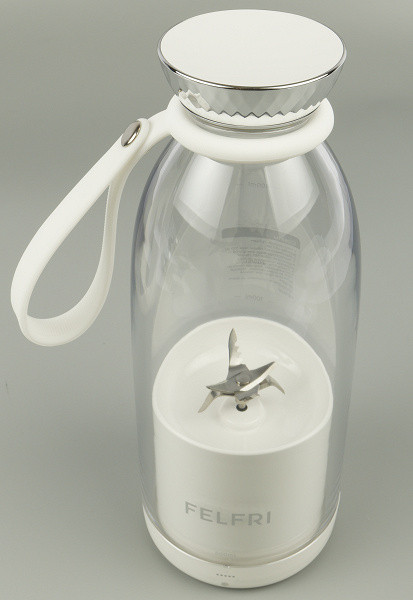
Thus, a portable blender can be useful not only for those who adhere to a healthy lifestyle, but also for those who are temporarily deprived of access to electricity. Let's remember the situation when in the summer you are at the dacha and the lights are turned off. In such cases, a blender becomes a real salvation, especially if you need to quickly prepare puree soup for an old grandmother or prepare nutritious puree for a baby.
While a portable blender isn't an essential item, it can be incredibly useful in the right circumstances. It remains to be seen how effective the Felfri model will be.
Characteristics
| Manufacturer | Flawless |
|---|---|
| Model | FHB-002 |
| Type | blender |
| Country of manufacture | China |
| Guarantee | 1 year |
| Life time* | 10 years |
| Declared power | 60 W |
| Battery capacity | 2400 mAh |
| Charger | 5 V 1.5 A |
| Corpus material | plastic |
| Case color | white |
| Control type | mechanical |
| Number of speeds | 1 |
| Speed in main mode | 7000—23000 rpm |
| Knife shape | 6-petal |
| Jug material | plastic |
| Jug volume | 500 ml |
| Dimensions (W×H×D) | 90×235×90 mm |
| Net weight | 741 |
* Contrary to popular belief, this is not the time limit after which the device will necessarily break down. However, after this period, the manufacturer ceases to bear any responsibility for its performance and has the right to refuse to repair it, even for a fee.
Equipment
The blender is presented in black cardboard packaging. On the front side there is an image of the blender itself, the company logo and the name of the device. The packaging also describes in detail the key characteristics of the blender: 500 ml capacity, charge level indication, the ability to carry out 30 blendings on one charge, 6 blades, the presence of a replaceable bottom without a motor and information on battery capacity.
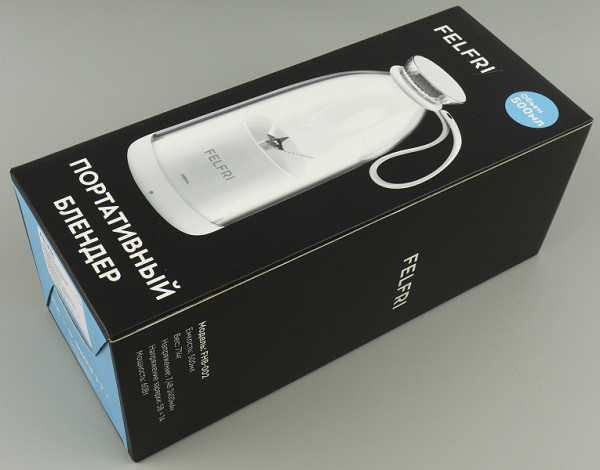
Opening the box, we found:
- blender body
- charging station with charging port, motor and knife
- replaceable bottom without motor in a black box
- cover
- USB charging cable
- bag for transporting the blender
- instructions
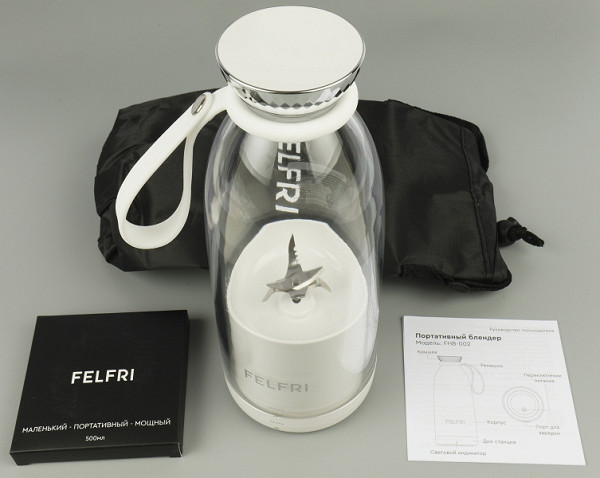
At first sight
The blender has an elegant design, made in white and silver colors. Particularly noteworthy is the stylish cover, as well as the pleasant-to-touch strap, which makes it easier to carry the device.
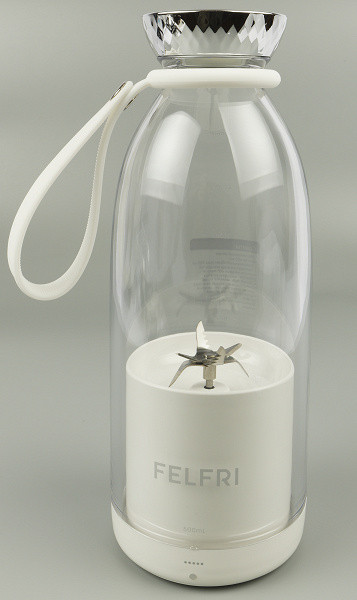
The device itself consists of a plastic transparent glass and a docking station, which can be replaced with a replaceable bottom without a motor if necessary, for example, transporting the blender to the gym.
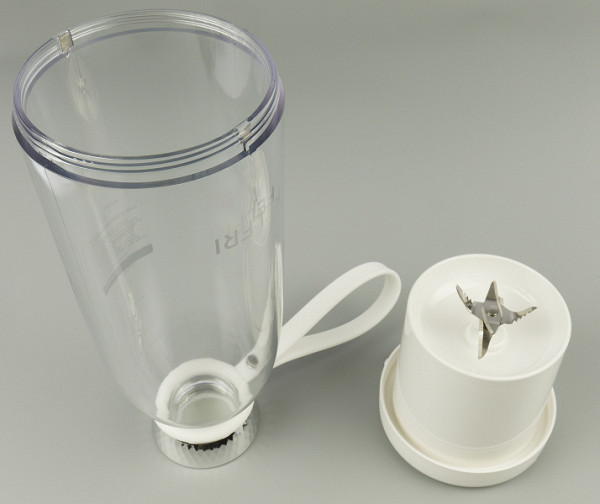
At the bottom of the docking station there is a blender switch and information about the device.
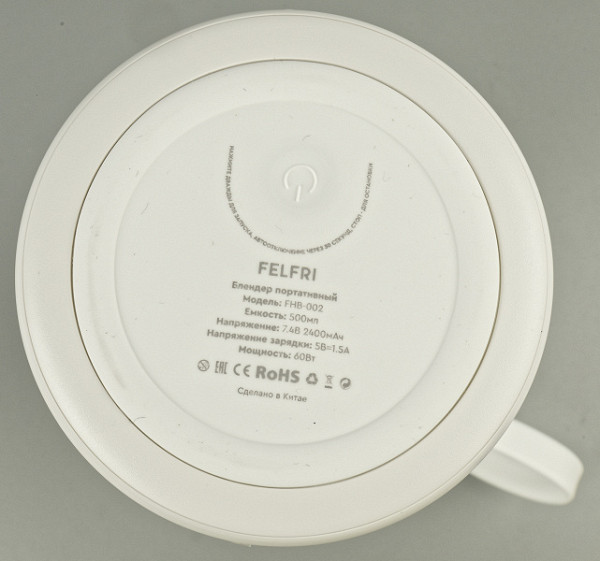
There is a USB port on the side of the docking station for convenient charging of the device. On the opposite side there is a charge level indicator, which glows green during operation and, in case of overload, changes its color to red.
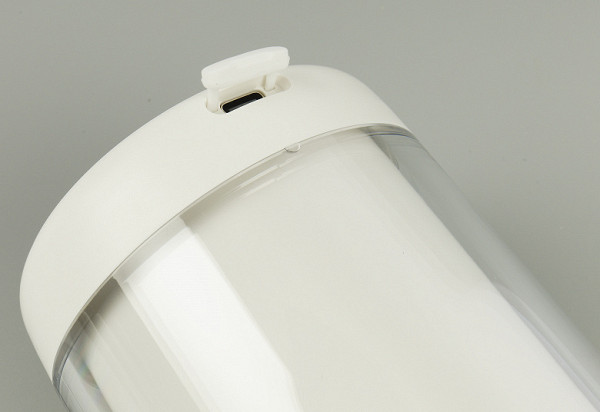
The device is equipped with a 6-blade knife that allows you to puree food.
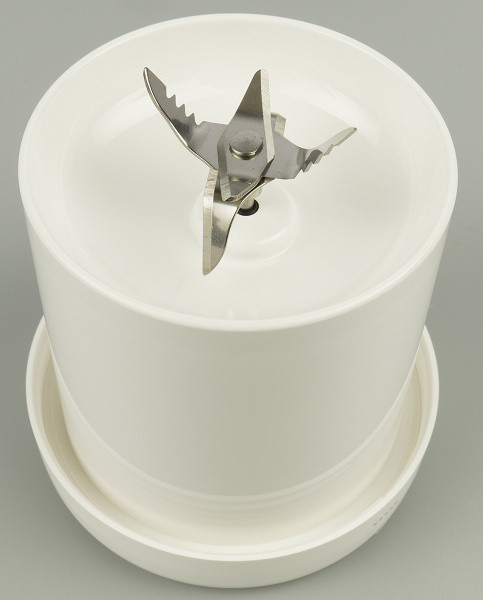
Also included is a bottom without a motor and a USB cable.
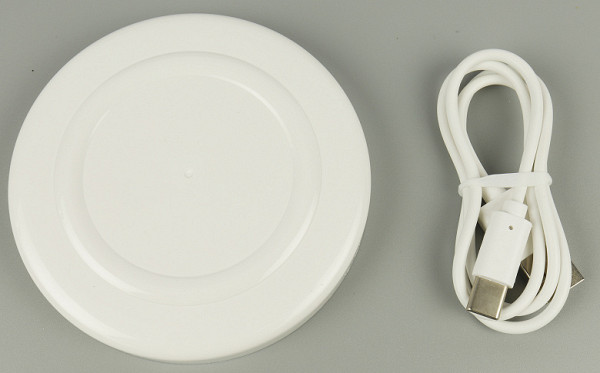
In the box we also found a thermal bag with long, comfortable handles.
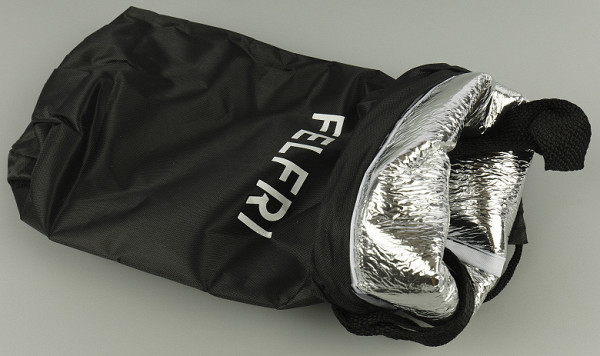
By replacing the docking station with a non-motorized bottom, the blender transforms into a convenient bottle with a lid that you can easily take with you anywhere and also keep the contents warm. The presented photo shows that the blender easily fits into a bag, creating a stylish and practical accessory.
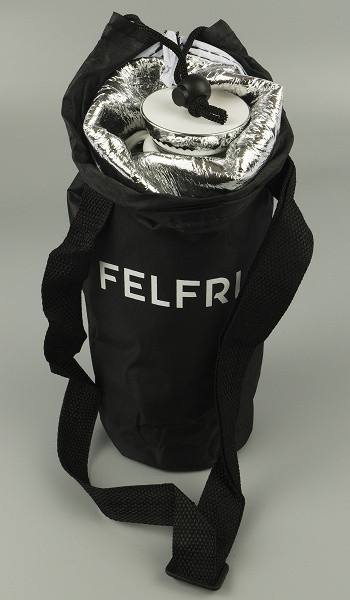
Instructions
The instructions are printed on standard-weight paper and unfolded into a strip of five squares for reading.
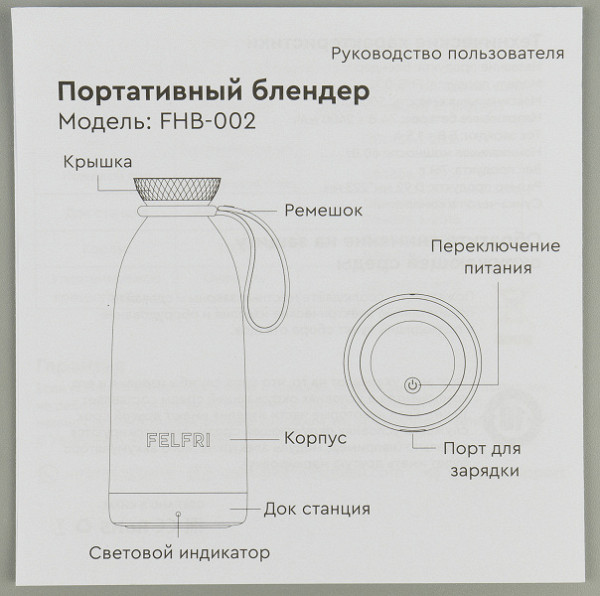
The user manual provides general recommendations for operating the device, solving possible problems, the charging process, first start-up, care and maintenance of the device. Information is also provided on compliance with hygienic standards when working with food, declaration of conformity, warranty conditions and technical specifications.
Control
Controlling the blender is as simple as possible: just place the products in the device, close the lid and press the switch located at the bottom of the case twice. The mixing process takes only 30 seconds, after which the device automatically turns off; The green indicator lights up during the entire operating time.
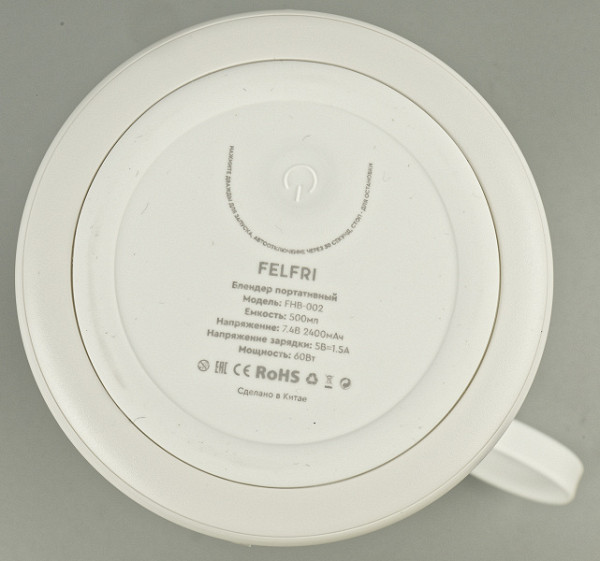
If you want to shut down earlier, you need to press the power off button again.
This completes all the subtleties of blender control.
Exploitation
The operation of the device also turned out to be extremely simple. Before first use, we thoroughly cleaned the device with detergent. It is important to note that the docking station cannot be submerged in water, but it can be washed. After that, we completely dried the device and charged the battery according to the instructions.
The blender is equipped with a double safety system: if the «500 ml» marking on the bottle does not match the indicator light on the base of the blender, the device will not start. The indicator light will flash green 5 times to indicate a discrepancy. The blender will only begin to function when the bottle is correctly aligned with the base, the indicator light will turn green and the unit will be activated by pressing the power button twice.
It is important to respect the maximum capacity of the blender (do not exceed the level of the strap), and also take into account the content restrictions — the maximum allowed amount of ice is 300 ml, and fruit — 400 ml. The blender should not be used for hot water (temperatures above 60°C) or carbonated drinks.
Screw the lid on tightly, and do not turn on the blender with the lid off for obvious safety reasons. It should be noted that the portable blender is not intended for blending meat, nuts or soy products.
For a battery that was charged before first use, there was no need to recharge during the tests.
Care
Before starting the cleaning procedure, you should make sure that the blender blades do not rotate (which, of course, is extremely logical). It is important to avoid using steel balls (who would even think of using steel balls?) and abrasive cleaners, as well as harsh liquids. The inside of the blades can be quickly cleaned with water (as long as it is not soaked) and then dried thoroughly. When storing, make sure that the device is completely dry and clean.
It is also important to remember that drinks prepared in a blender should be consumed immediately, and it is not recommended to store them in the bowl of the device to avoid possible odor and rotting of the products.
Practical tests
Tomato test
To carry out the traditional tomato test, which we use to test all blenders, we took two tomatoes and cut them quite coarsely.
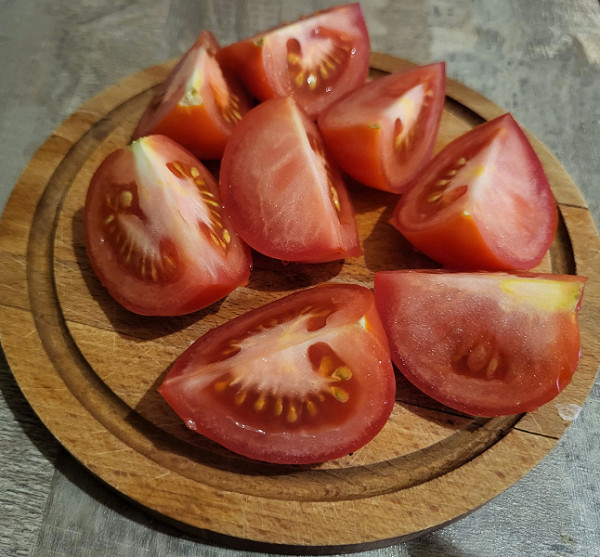
We put it in a blender — as it turned out, you can put food in a blender not only through the narrow neck, but also through the bottom.
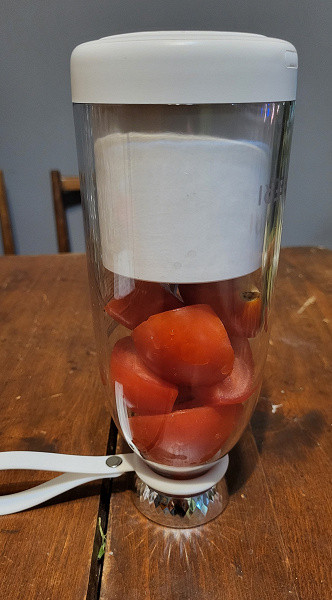
We started the blender, after 30 seconds (as set by the program) it finished working and stopped.
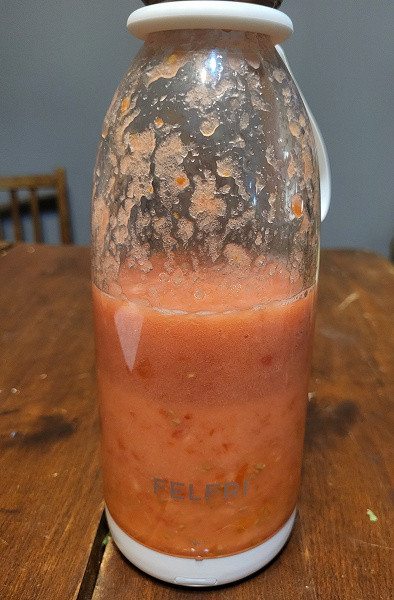
The photo below shows that the seeds and skin residues got into the space between the docking station and the walls of the bottle and, accordingly, were not ground properly.
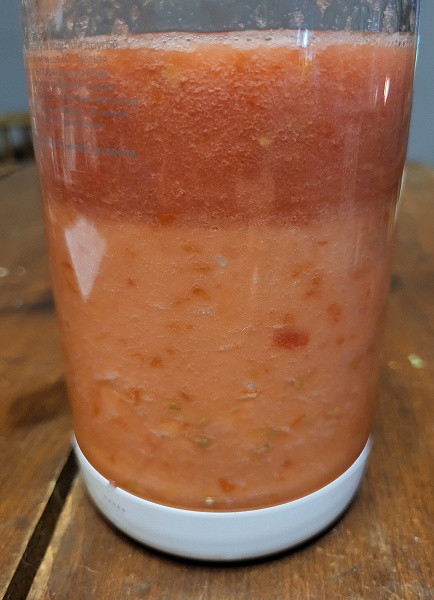
Here you can see quite large fragments of tomato skin and seeds.
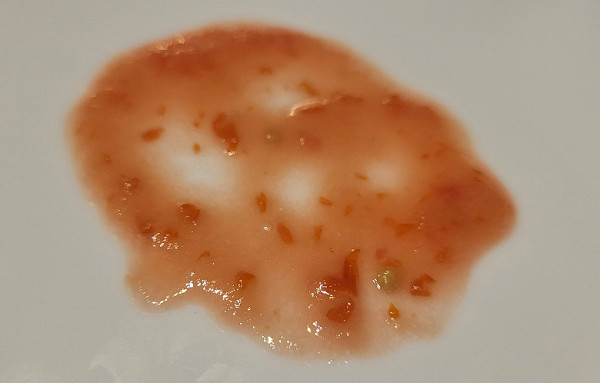
Result: satisfactory
Buckwheat smoothie with banana
It is clear that a portable blender is mainly intended for making healthy drinks, so we started with smoothies. To make the smoothie more healthy, we added buckwheat. Recipes for such smoothies, of course, advise not to cook the cereal in order to preserve the beneficial substances, but to pour boiling water over raw buckwheat for a couple of hours or overnight, or even better, take green buckwheat, which has much more benefits, but we didn’t take risks and took some cooked the day before porridge, put it in a blender and added a banana for sweetness.
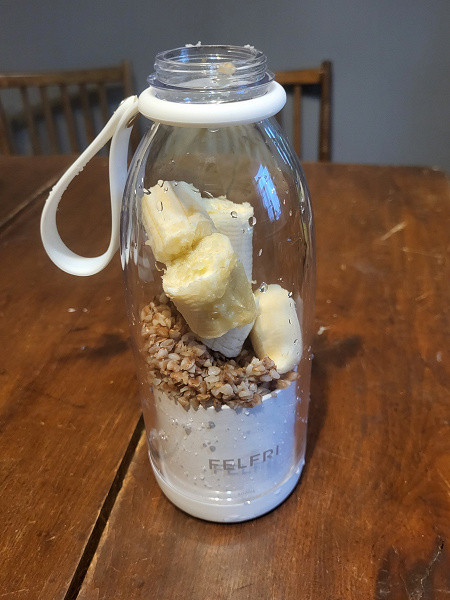
They poured milk all over it
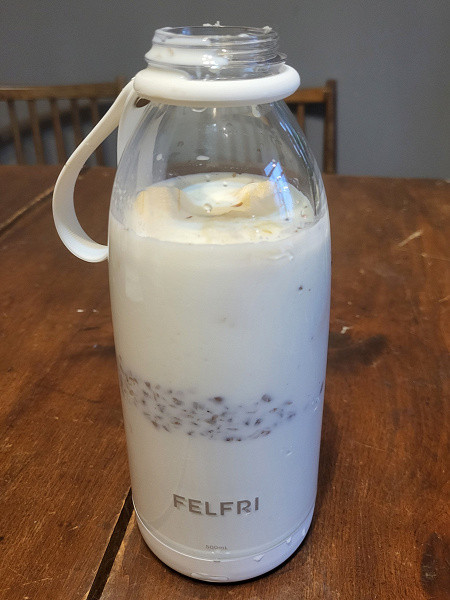
and turned on the blender. After 30 seconds, the contents were ground, and the result was a real smoothie.
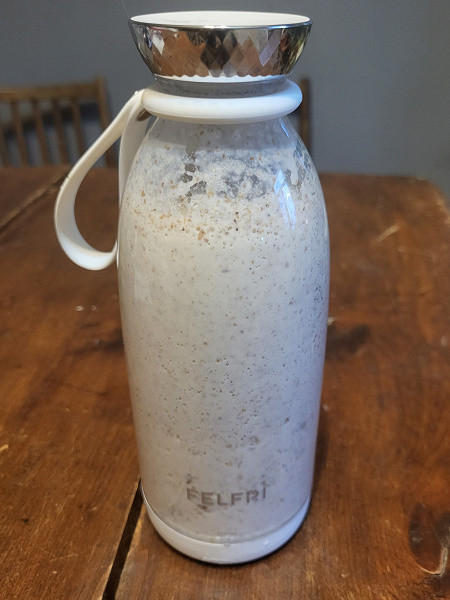
We still didn’t drink from the bottle, as the manufacturer recommended, but poured the smoothie into a cup.
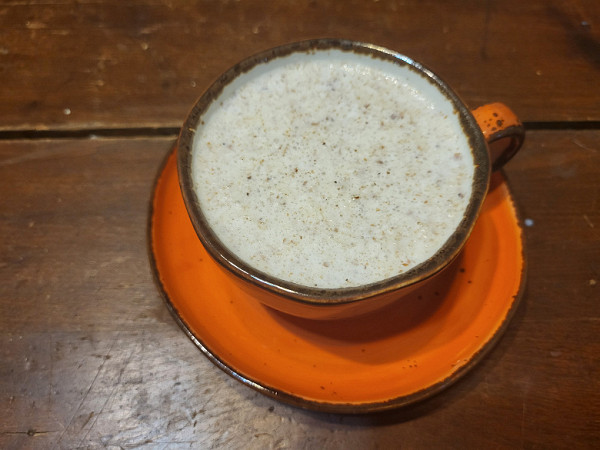
The consistency turned out to be quite homogeneous, but it is clear that pureing buckwheat is an almost impossible task.
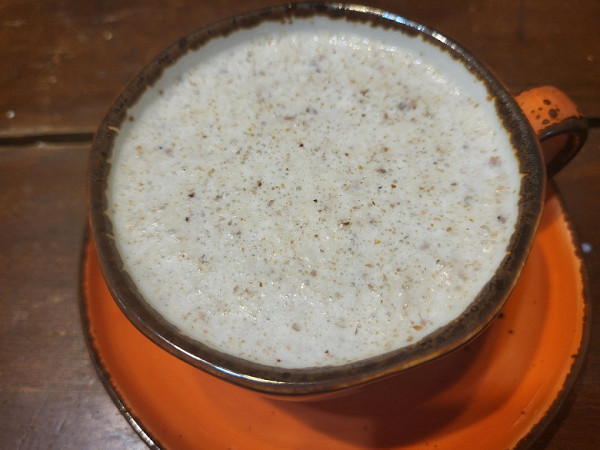
In addition, there were small unground pieces of banana in the finished smoothie. We assume that the problem is again in the gap between the docking station and the bottle itself, into which pieces of food sometimes slip. Although we shook the blender (the manufacturer recommends tilting the device at 45 degrees), apparently not everything was shaken out for thorough pureeing.
Nevertheless, we were pleased with the result, and the smoothie turned out great.
Result: good
Smoothie with mango puree and banana
The next experiment was a smoothie made from mango puree, banana and milk. We bought frozen mango puree, let it warm up a little, put two spoons of puree in the blender and added a banana.
Here it should be noted again that the neck of the bottle is quite narrow, and it is not very convenient to put food through it (but it is convenient to drink from such a neck); so we screwed the lid on tightly, turned the blender upside down, and poured food through the wide base.
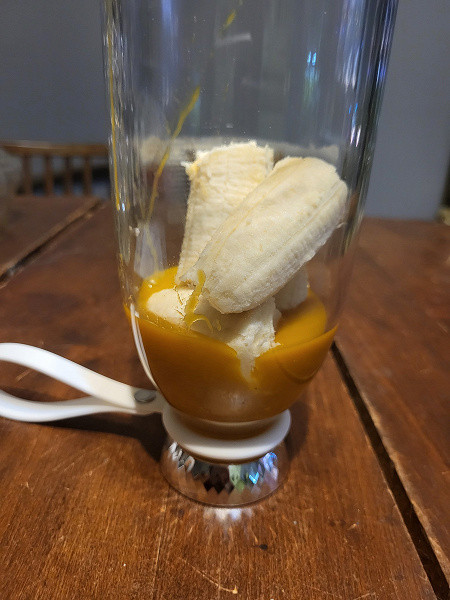
We added the ingredients and poured milk over them, leaving the blender in the same position. The blender lid is quite stable and does not tend to tip over, which eliminates the worry of it flipping over. However, when loading food, it is convenient to hold the device by hand for added confidence.
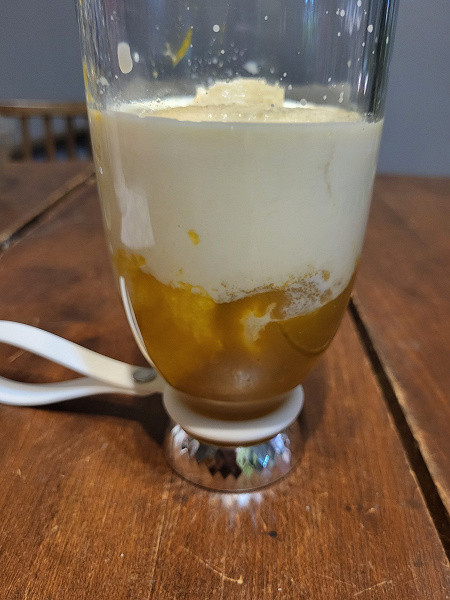
Without changing the position of the blender, we screwed the base with the knives.
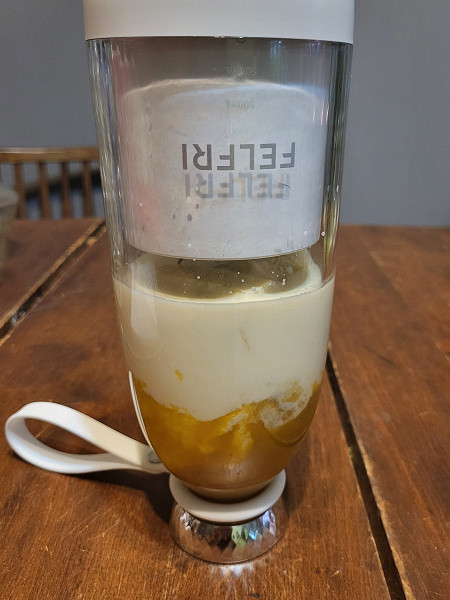
And only after that they turned the device over and turned it on. The smoothie turned out to be homogeneous and of high quality, and this time we didn’t come across any banana pieces (perhaps we shook the device more intensely).
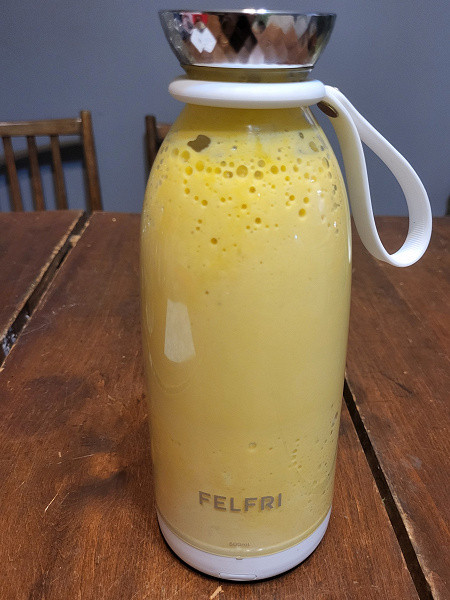
Pour the smoothie into a glass and drink. In the photo below you can see how the smoothie fills the gap between the base with knives and the bottle.
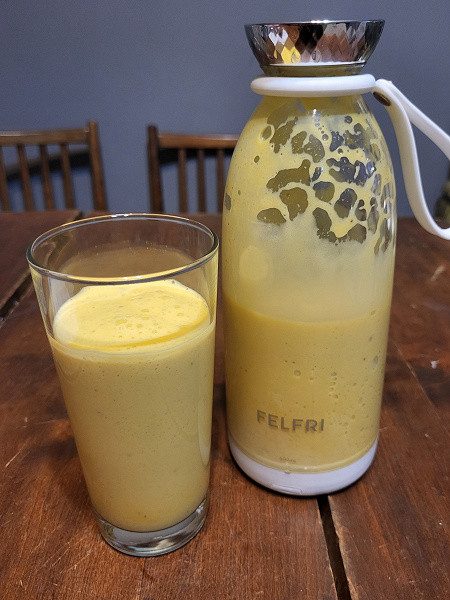
Result: excellent
Cheese cream soup
The next point of our tests was cream cheese soup. All recipes for this dish recommend using an immersion blender (which is, of course, easier and easier), but what if you don’t have an immersion blender and only have a portable one?
We decided to see what would happen. Peeled and cut potatoes, carrots and onions.
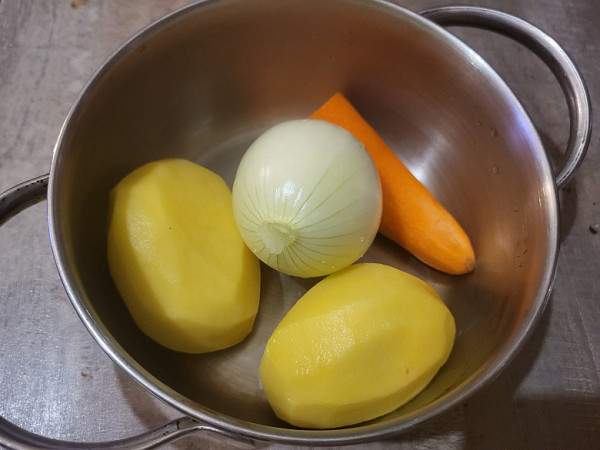
The potatoes were sent to boil, and the onions and carrots were fried in a frying pan,
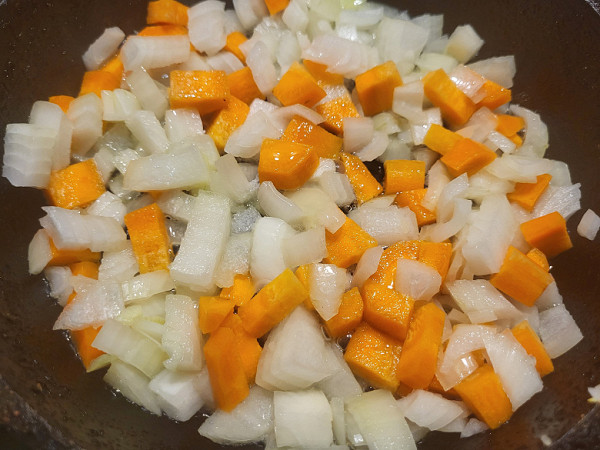
then added them to the potatoes and cooked until soft.
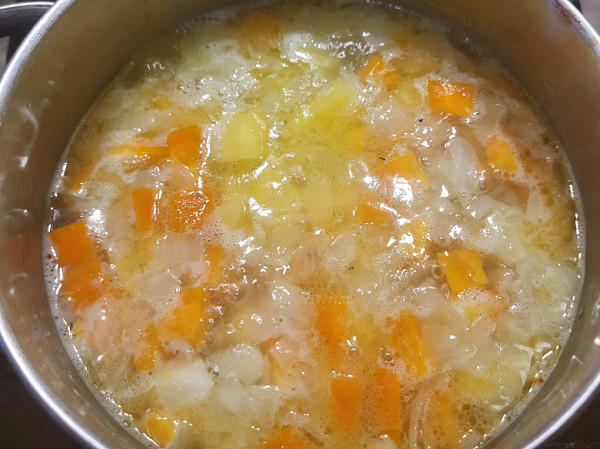
Then we caught the vegetables from the pan and put them into the blender (as in the previous test, after turning it over and putting the products through the wide part of the bottle).
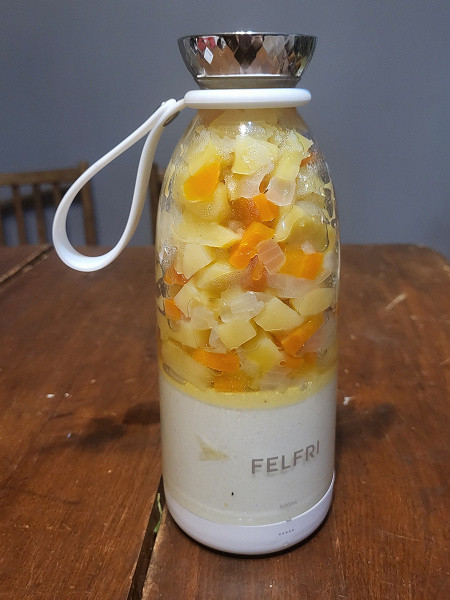
However, we ignored the manufacturer's recommendation not to add more than 400 ml of fruits (or vegetables, in our case) to the blender. We filled the bottle with vegetables almost to the very top, and, as a result, we got a predictable result: the lower part froze, even with intense shaking of the device.
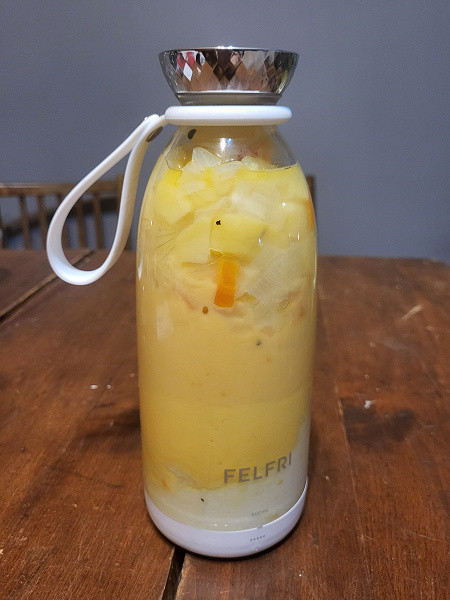
I had to put out some of the vegetables so that there was more free space in the bottle, and here the blender already worked as it should:
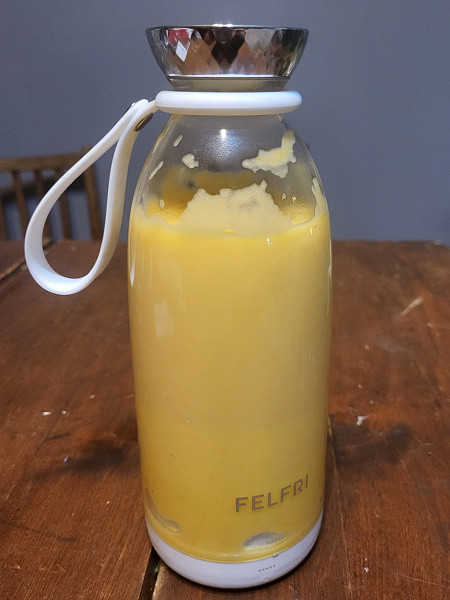
We were completely satisfied with the consistency of the resulting vegetable puree.
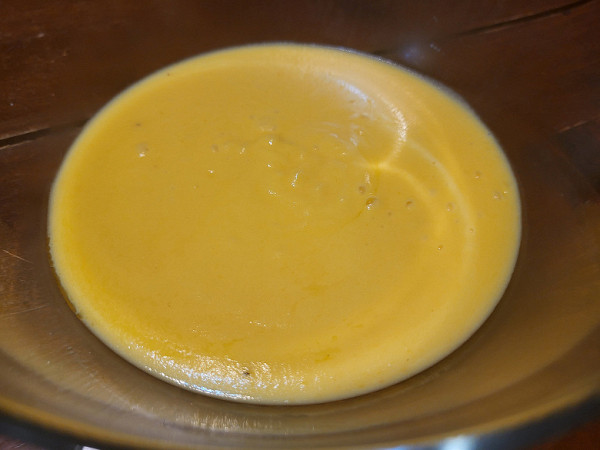
We put the puree back into the pan, added the remaining vegetable broth, two spoons of processed cheese, salt, pepper, a little nutmeg and got a creamy cheese soup, which we garnished with wheat croutons and a sprig of dill.
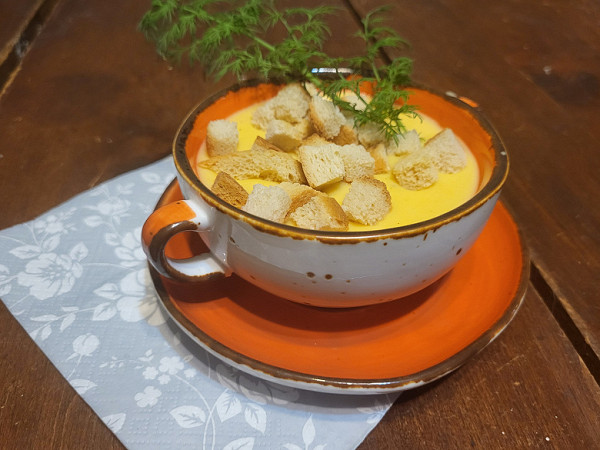
Result: excellent
Sea buckthorn pureed with sugar and sea buckthorn smoothie
Well, since we initially talked about berries mashed with sugar, we decided to try it. We had sea buckthorn lying around in the freezer, we took it out, put it in a blender and covered it with sugar.
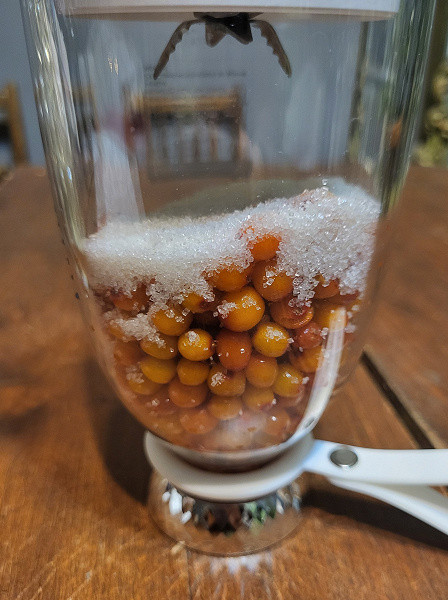
We turned on the blender and after 30 seconds we got the result shown in the photo below: the berries were ground, but the sea buckthorn seeds were clearly visible. However, even a more powerful blender cannot cope with them.
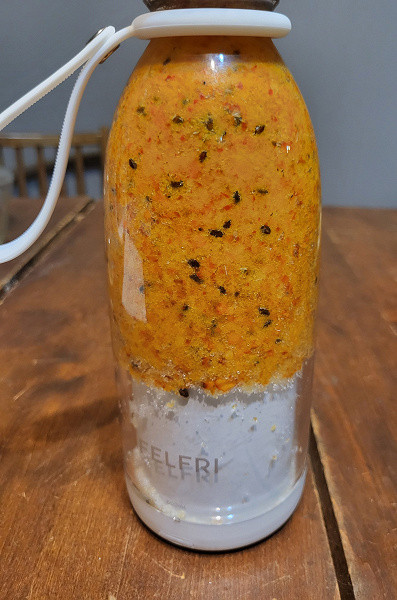
The photo below shows the contents of the blender after 30 seconds of operation. Seeds and whole berries are visible. But let us remind you: the sea buckthorn was frozen, which makes it difficult to process the berries. With fresh blueberries or strawberries the result would be completely different.
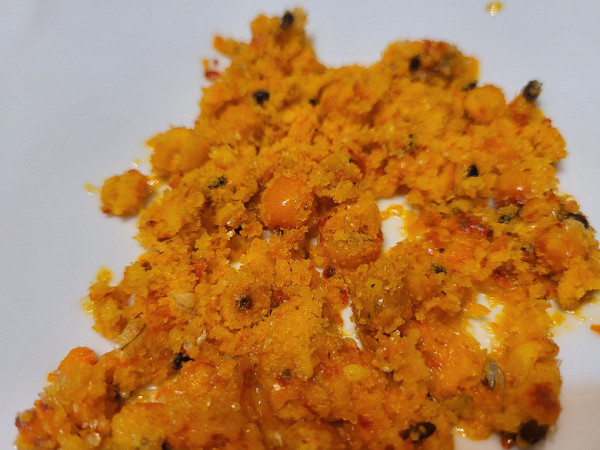
We didn’t want to eat sea buckthorn in this form, so we decided to make a smoothie from sea buckthorn, banana and yogurt ground in a blender. Place all ingredients in blender
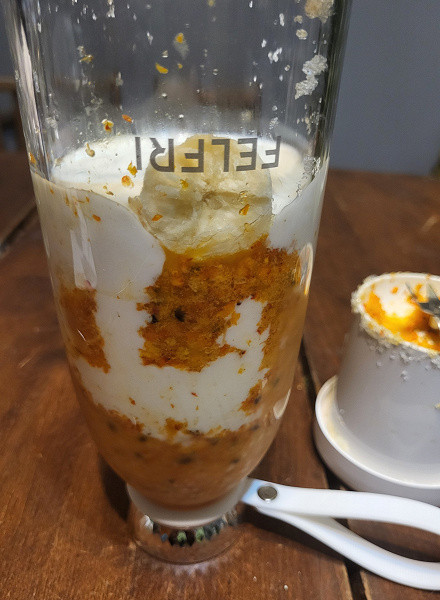
and got an excellent sea buckthorn-banana smoothie,
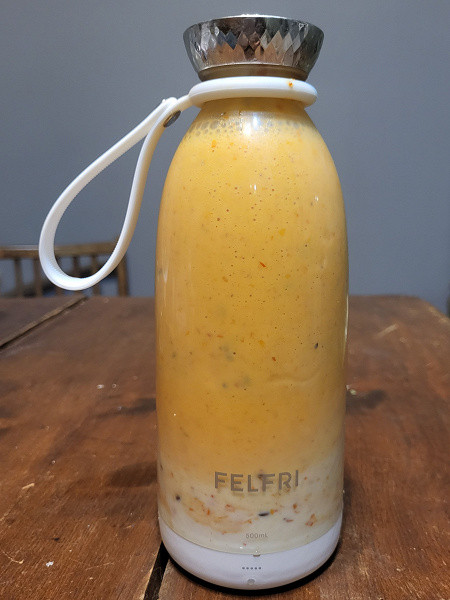
which we consumed with pleasure.
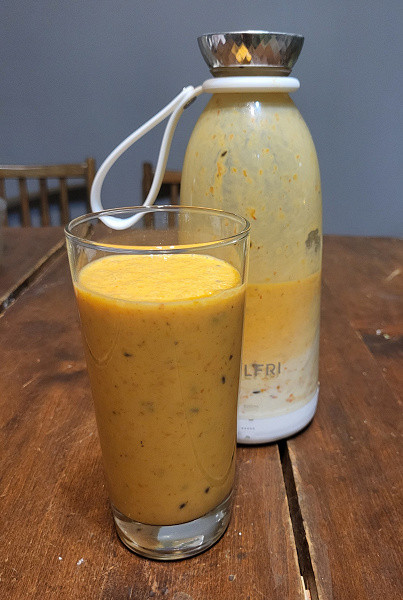
Result: good
conclusions
The Felfri portable blender lives up to its expectations as a simple and convenient device. Although we used it infrequently, during the entire period of operation we charged the blender only once — at the very beginning. So its charges last quite a long time, although we didn't reach the claimed 30 whisks as stated on the packaging.
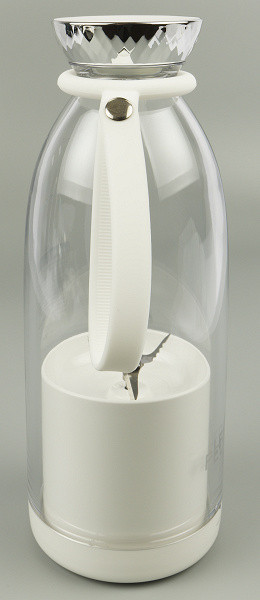
Using a portable blender, you can make smoothies, pureed soup, and even berries pureed with sugar. The main thing is to tilt and shake the device a little in time so that parts of the food do not get stuck between the body and the docking station.
Pros:
- can be easily taken with you
- Thermal bag included
- capacious battery
Minuses:
- Pieces of food get stuck between the body and the docking station and are not pureed completely
